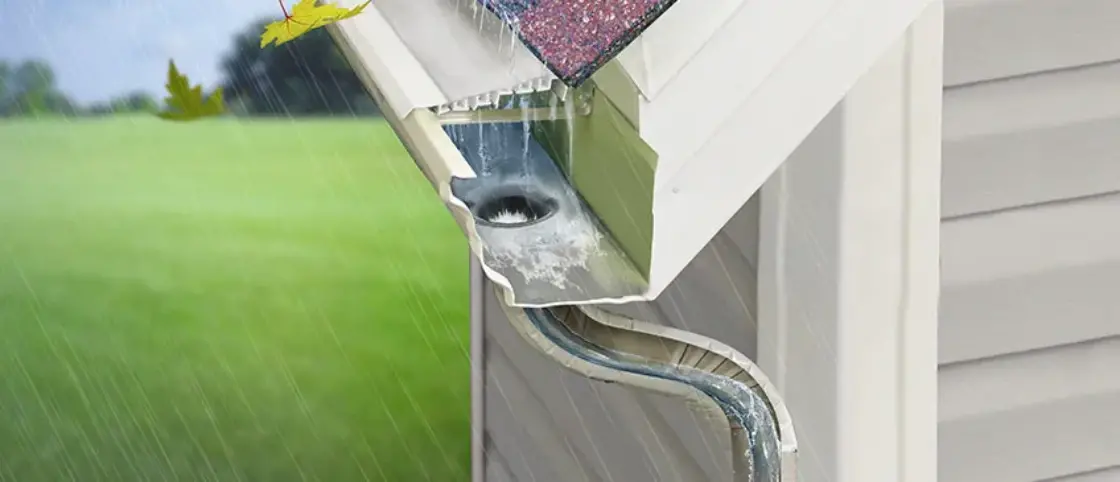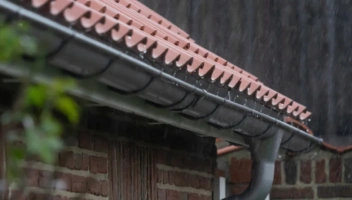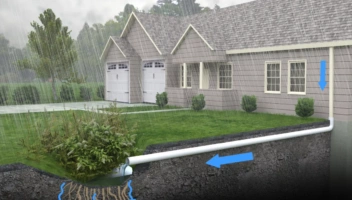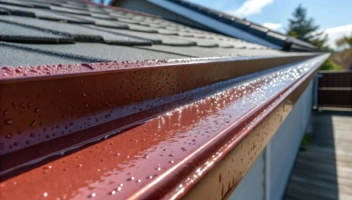Why Are Gutters So Important?

Gutters are usually the part of your home that remains “out of sight, out of mind,” however, your home’s rain gutters are vital to the health of your home. If you don’t have gutters, you’re looking at a plethora of problems, which can be costly and serious. Fail to keep up with its regular maintenance? Even more problems.
Essentially, gutters are channels installed along the edge of your home’s roof that collect rainwater and direct it away from your home through downspouts. This simple system helps protect your home’s foundation, siding, and landscaping from excessive water exposure. In this article, we’ll explain why it’s so important for homeowners to have gutters installed and maintained.
Why Are Gutters Important?
Gutters have one crucial job: to channel water away from your home. When it rains or snows, gutters collect the water running off your roof and direct it into downspouts, carrying the water safely away from your home’s foundation, siding, windows, and doors. Without this system, you could face serious and costly damages, including foundation cracks, basement flooding, and mold growth.
- Protecting the Home’s Foundation: Gutters divert water away from your home’s foundation, preventing water pooling that can cause cracks and weakening.
- Preventing Home Water Damage: By routing water away from your house, gutters protect your siding, windows, doors, and roof from water damage that can lead to mold and mildew growth.
- Routing Water Away from Landscaping and Walkways: Properly functioning gutters help prevent soil erosion around your home, which can harm your garden and create uneven walkways.

Factors to Consider When Looking Into Gutters for Your Home
While not legally required by law, rain gutters are vital to maintaining an effective drainage system for your home. Most homes benefit from having gutters, especially those in regions with heavy rain or snowfall. There are various types of gutters. Here are key factors to consider when determining your gutter needs:
- Climate and Rainfall in Your Area: The amount and frequency of rainfall in your region will influence the type of gutter system you need. If you live in a region with heavy rainfall, like the Pacific Northwest, or areas with significant snowfall, such as the Upper Midwest, investing in a robust gutter system is essential to manage water runoff effectively.
- Roof’s Slope and Design: The design and pitch of your roof play a critical role in how quickly water flows into the gutters. Steeper roofs may require larger gutters to handle the increased water flow and prevent overflow. Aluminum gutters provide a sturdy option.
- Your Home’s Position on the Property: Homes situated on slopes or in valleys have unique drainage needs compared to those on flat terrain. Properly designed gutters can help manage these challenges by effectively channeling water away from your home.
- Soil and Landscape Around Your Home: Different soil types absorb water at varying rates. Understanding your soil’s capacity can help determine the appropriate gutter system to manage water runoff and prevent erosion or flooding around your home.
Pros and Cons of Having Gutters
While rain gutters help prevent water damage, they come with their own set of challenges. Let’s explore some of the most common pros and cons of installing and maintaining gutters:
Pros
- Protect Foundation of Your Home: Gutters safeguard the structural integrity of your home by diverting water away from the exterior foundation, preventing cracks and weakening.
- Reduces Maintenance Costs: With proper gutter installation and upkeep, gutters can save you money by avoiding expensive repairs due to water damage.
- Protects Landscaping: By channeling water away from gardens and landscaping, gutters help preserve the health and aesthetics of your outdoor spaces.
- Prevent Basement Flooding & Water Damage: Functioning gutters prevent water from pooling around your home’s foundation, reducing the risk of basement flooding and structural damage.
- Harden Home for Wildfires: In wildfire-prone areas, gutters can reduce the accumulation of debris and flammable materials on your roof, offering additional protection.
Cons
- Gutters Can Get Clogged: Without regular cleaning, leaves, twigs, pine needles, and other debris can block gutters, causing overflow and potential water damage.
- Initial Gutter Installation Cost: Installing gutters involves an upfront cost that varies based on the size and design of your home.
- Regular Maintenance Required: Gutters require regular cleaning and maintenance to function properly. Neglecting this can lead to overflow and damage to the fascia board.
- Ice Dams: In colder climates, improper gutter pitch can cause snow or ice to build up, leading to ice dams. These can damage gutters and cause leaks inside your home.
- Pest Infestation: Clogged or damaged gutters can collect standing water, attracting mosquitoes and insects. Debris buildup can also invite birds, rodents, and other pests looking for nesting sites.
Maintaining Your Gutters
We know keeping your new gutters in top shape is crucial for protecting your home from water damage. Here’s a straightforward, step-by-step approach to gutter maintenance benefits that will help you stay on top of things:
- Clean Regularly: Make sure your gutters are free of leaves, twigs, and other debris to prevent clogs and water overflow. Cleaning your gutters at the end of spring and fall is essential to ensure they function correctly.
Tools needed: A sturdy ladder, gloves, a trowel or gutter scoop, and a garden hose. - Install Gutter Guards and Covers: To minimize the amount of debris entering your gutters, consider installing gutter guards. These covers help keep leaves and other debris out while allowing water to flow freely. This step can significantly reduce the frequency of cleanings.
Tools needed: Gutter guards or covers, screwdriver, and drill. - Inspect for Damage: Regularly inspect your gutters and downspouts for any signs of damage or leaks, such as rust spots, holes, or sagging sections. Addressing these issues promptly can prevent minor problems from becoming major headaches.
Tools needed: Sealant, pliers, and replacement hardware as necessary. - Ensure Proper Attachment and Pitch: Periodically check that your gutters are securely attached to the house and pitched correctly toward the downspouts. The right pitch ensures water flows smoothly and prevents pooling and overflow.
Tools needed: A level and a hammer or screwdriver.
Following these steps, you can maintain your gutters effectively and protect your home from potential water damage.
When Should My Gutters Get Replaced?
Gutters are essential for most homes, but knowing when to replace them with new gutters can save you from significant water damage and higher repair costs down the road.
- Persistent Clogs: If your gutters still clog frequently despite regular cleaning, it might be time for an upgrade.
- Rust or Corrosion: Visible rust or corrosion can weaken your gutters, preventing them from functioning properly.
- Sagging or Pulling Away: Gutters that sag or pull away from the roofline indicate they can’t handle water flow effectively.
- Cracks and Holes: Visible cracks or holes can cause leaks and reduce gutter efficiency.
We recommend investing in professionally installed gutters rather than DIY gutters. Professional gutter installation experts ensure your gutters are correctly fitted and pitched, maximizing their effectiveness. Additionally, consider installing a gutter guard system. Gutter guards block out debris, minimizing clogs and making maintenance easier. This small investment can save you time and money in the long run, keeping your home safe and dry.
Protect Your Home with Reliable Gutters
Gutters are a crucial component of maintaining your home’s integrity. By understanding the importance of seamless gutters and keeping them well-maintained, you can save on costly repairs and protect your property from water damage. If you’re considering installing or upgrading your gutter system, the LeafFilter team is here to help. Reach out to us to find the best solution for your home and enjoy a lifetime of protection—guaranteed!
Schedule your free no-obligation consultation today.
Frequently Asked Questions
Is it okay to not have gutters?
It’s generally not advisable to go without gutters. Without them, storm water can cause significant damage to your home’s foundation, siding, and landscaping. Gutters help direct water away from your home, protecting your property and saving you from costly repairs in the long run.
Is there an alternative to gutters?
Yes, there are a few alternatives to traditional gutters, such as rain chains, drip edges, and ground gutters. However, these options might not be as effective in managing large volumes of water and protecting your home from potential water damage.
How often do I need to maintain or clean my gutters?
It’s recommended to clean and inspect your gutters at least twice a year—once in the spring and once in the fall. If you have many trees around your home, you might need to do this more frequently, especially during the rainy season, to prevent clogs and ensure proper water flow.
What types of houses or structures don’t necessarily need gutters?
Homes with steeply pitched roofs that extend far beyond the walls might manage rainwater runoff more effectively without gutters. Additionally, structures in a dry climate like Arizona that don’t get much rainfall may not require gutters. However, this is rare, and most homes benefit significantly from having a proper gutter system.
Editor’s Note: This post was originally published in May 2018 and has been updated for accuracy and comprehensiveness.


